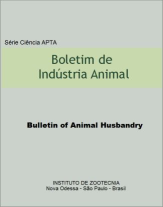Perfil sanitário e eficiência da inseminação artificial em tempo fixo de rebanhos bovinos de pequenos produtores da região de Piracicaba
DOI:
https://doi.org/10.17523/bia.v72n3p221Palavras-chave:
doenças da reprodução, IATF, índices reprodutivos, inquérito sorológico, sororeatividade.Resumo
O objetivo do estudo foi avaliar os índices reprodutivos de rebanhos bovinos submetidos a um programa de inseminação artificial em tempo fixo (IATF) na região de Piracicaba, SP. Vinte rebanhos, formados de 10 a 80 vacas leiteiras mestiças, foram selecionados para participar de um programa de melhoramento genético, através de IATF. Inicialmente, foi realizado um levantamento da incidência de doenças reprodutivas presentes nos rebanhos. Para tanto, amostras de sangue foram coletadas aleatoriamente de cada rebanho para o diagnóstico sorológico de Brucelose, Leptospirose, Rinotraqueíte infecciosa bovina (IBR), Diarreia viral bovina (BVD), Leucose enzoótica bovina (LEB) e Neosporose. Os exames laboratoriais foram realizados conforme metodologia recomendada pela Organização Mundial de Saúde Animal. Todos os rebanhos apresentaram pelo menos um animal positivo para uma ou mais doenças reprodutivas. Brucelose foi detectada em 3/20 (15%), IBR e BVD em 19/20 (95,0%), LEB em 20/20 (100%), Neosporose em 13/20 (65,0%) e Tuberculose em 8/8 (100%) rebanhos. Seis meses após, vacas (n=203) dos diferentes rebanhos foram submetidas a um tratamento hormonal a base de estradiol-progesterona e PGF2α para sincronizar o cio e a ovulação, visando a IATF. Os dados foram analisados por regressão logística e pelo teste exato de Fisher. As taxas de prenhez aos 30 e 60 dias após IATF foram de 55,7% e 48,3%, respectivamente, sendo que essas taxas não foram influenciadas pelo rebanho, inseminador, escore corporal, dias pós-parto ou número de lactação. A taxa de parição (42,4%) diferiu da taxa de prenhez aos 30 (P=0,01), mas não aos 60 (P=0,27) dias pós IA. A perda gestacional até o parto foi de 23,2% (26/112), porém, não foi identificada a causa precisa desse evento. Apesar da presença (sororeatividade) de doenças reprodutivas, rebanhos bovinos de pequenos produtores apresentam aceitáveis taxas de prenhez após IATF. Todavia, sugere-se a adoção de medidas profiláticas adicionais, tais como vacinação e melhorias no manejo zootécnico.Downloads
Downloads
Publicado
Edição
Seção
Licença
Os autores não serão remunerados pela publicação de trabalhos, pois devem abrir mão de seus direitos autorais em favor deste periódico. Por outro lado, os autores ficam autorizados a publicar seus artigos, simultaneamente, em repositórios da instituição de sua origem, desde que citada a fonte da publicação original seja Boletim de Indústria Animal. A revista se reserva o direito de efetuar, nos originais, alterações de ordem normativa, ortográfica e gramatical, com vistas a manter o padrão culto da língua e a credibilidade do veículo. Respeitará, no entanto, o estilo de escrever dos autores. Alterações, correções ou sugestões de ordem conceitual serão encaminhadas aos autores, quando necessário. Nesses casos, os artigos, depois de adequados, deverão ser submetidos a nova apreciação. As opiniões emitidas pelos autores dos artigos são de sua exclusiva responsabilidade. Todo o conteúdo deste periódico, exceto onde está identificado, está licenciado sob a Licença Creative Commons Attribution (CC-BY-NC). A condição BY implica que os licenciados podem copiar, distribuir, exibir e executar a obra e fazer trabalhos derivados com base em que só se dão o autor ou licenciante os créditos na forma especificada por estes. A cláusula NC significa que os licenciados podem copiar, distribuir, exibir e executar a obra e fazer trabalhos derivados com base apenas para fins não comerciais.













